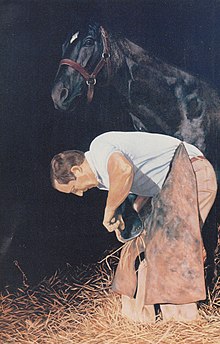Farrier

A farrier is a specialist in the care (cutting) and the fogging of animal hooves with horseshoes or other materials. The horseshoes and horseshoe nails he has traditionally also even in the forging process ago or the horseshoe fits the shape of the hoof to. The work also includes treating injured and sick hooves.
In Austria and Switzerland, "farrier" is the correct job title, in Germany the profession is officially called "farrier".
tasks
The traditional tasks of the farrier are shoeing with horseshoes and shortening and correcting barefooters. This also includes preparing the hoof for shoeing by cutting, knitting ( see: knitting iron ) and rasping the horn. In the case of positional errors, hoof diseases such as laminitis or hollow walls , etc., the blacksmith is also active therapeutically by supporting the healing by attaching special fittings.
In addition to shoeing, many farriers nowadays also offer the customization of hoof boots , which are either permanently glued to the hoof or put on the mount like a shoe for every ride .
Dental care, which traditionally also belonged to the tasks of the farrier, is now mainly carried out by veterinarians.
His field of work includes not only shoeing horses , but also other equidae ( donkeys , mules ).
Clawsmith
If necessary, shoing cattle (cows, bulls, oxen), insofar as they were used for transport and therefore their claws were severely worn, with so-called claw irons was one of the activities of a farrier. There were even blacksmiths who specialized as “claw smiths” and only shod cows. Hoof trimmers are still around, but normally cattle are no longer shod in Germany these days.
The profession of hoof trimmer differs significantly from that of the farrier in terms of training and the type of work performed.
education
Germany
In contrast to the hoof trimmer , the training of the farrier is regulated by law in Germany . Training to become a farrier used to require a completed training in metalworking as a basis, which was followed by an internship, an apprenticeship as a blacksmith and the state examination.
The following options are available today:
- Basic training in metal construction, specializing in metal design, core area farriery with journeyman's examination; followed by a four-month preparatory course at a state-recognized shoeing school and state shoeing examination.
- Any completed vocational training; one-month recognized introductory course; 24-month advanced training in employment subject to social security contributions at a state-recognized farrier who has been the farrier for at least three years full-time; followed by a four-month preparatory course at a state-recognized shoeing school and final state shoeing test. On request, the duration of the training can be shortened, for example through professional qualifications in the field of horse keeping.
- Transitional regulation: People who were already commercially active in hoof trimming before January 1, 2007 and who have practiced it for at least two years without interruption can attend the four-month preparatory course at a state-recognized farrier school within five years of the regulation coming into force and take the shoeing test.
Austria
The apprenticeship farrier in Austria has a training duration of 3 years and takes place in the sense of a dual training. In addition, there is the possibility of taking a master craftsman's examination and qualification examination.
Switzerland
The apprenticeship to become a farrier EFZ lasts 4 years. Prospective farriers attend vocational school one day a week . The third place of learning are the inter-company courses .
Trained farriers can specialize in becoming a qualified farrier. The quality mark is acquired in an SMU association course. A qualified farrier is committed to regular training.
A higher technical examination (federally certified blacksmith master) is in planning.
The old legal higher technical examination for blacksmith-farrier master according to the regulations of 1987 is no longer carried out because the professions blacksmith and farrier have developed apart.
See also
- Hufschmidt - old family name
- Hoof orthopedics
- Flagsmith
- Mountain blacksmith
- Guild sign
- Claw stance
Individual evidence
- ↑ Federal Ministry of Labor and Social Order: Regional priorities of the employment of employees in 97 branches of the economy Verlag Federal Ministry of Labor and Social Order, Statistics 1964, p. 58.
- ↑ Jörg Kleinert: Good luck charm always in hand - Marco Meyer works as a self-employed blacksmith. In: Braunschweiger Zeitung. August 13, 2088, accessed August 31, 2018 .
- ↑ https://www.gesetze-im-internet.de/hufbeschlg_2006/BJNR090010006.html Hufbeschlagsgesetz
- ↑ https://www.gesetze-im-internet.de/hufbeschlv/BJNR320500006.html Hufbeschlagsverordnung
- ↑ Further training opportunities for qualified farriers. (PDF) In: smu.ch. January 2015, accessed February 17, 2016 .
- ↑ a b Profession: blacksmith-farrier master HFP
Web links
Germany:
- German farriery law of April 19, 2006
- Farrier in Berufenet the Federal Employment Agency
- First German farrier association
Austria:
- Austrian Farrier Association
- Professional and industry information from the Austrian Chamber of Commerce
- Job description BIC
Switzerland:




